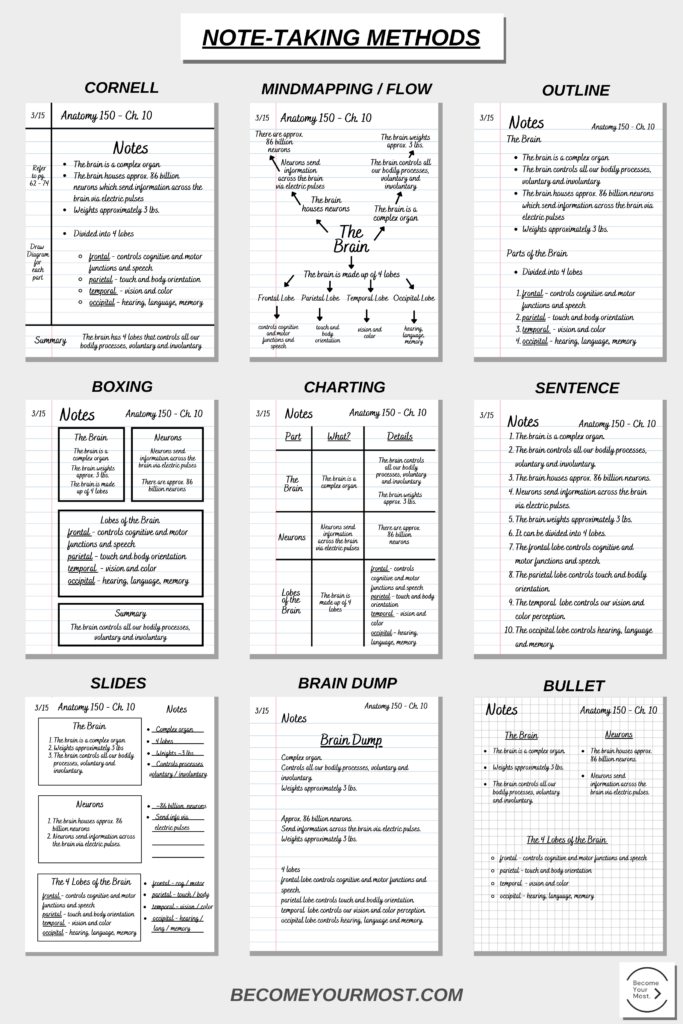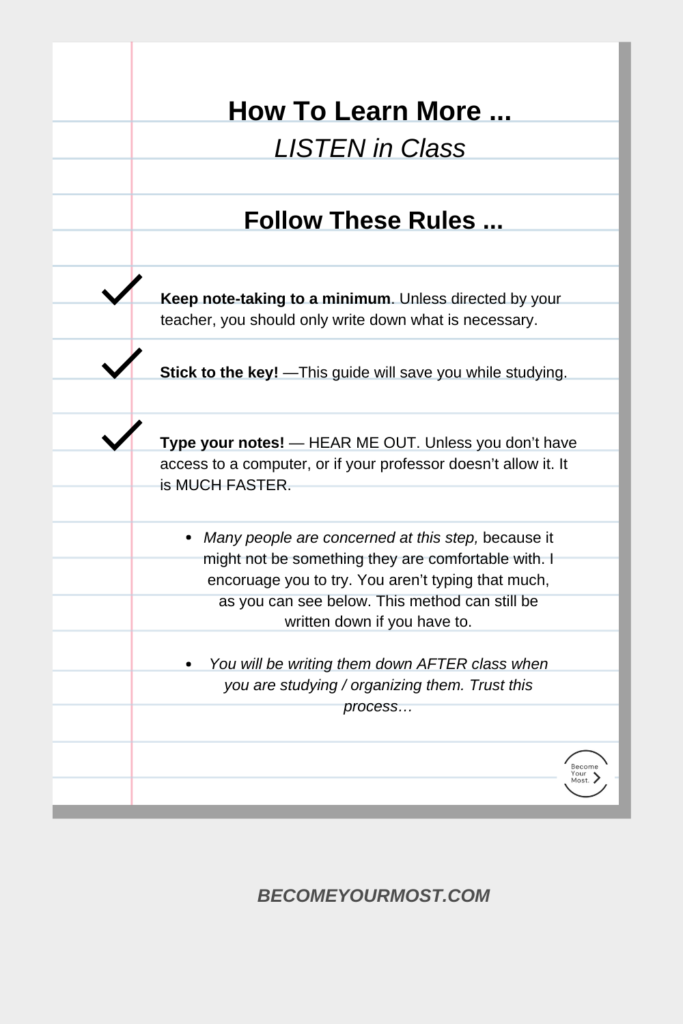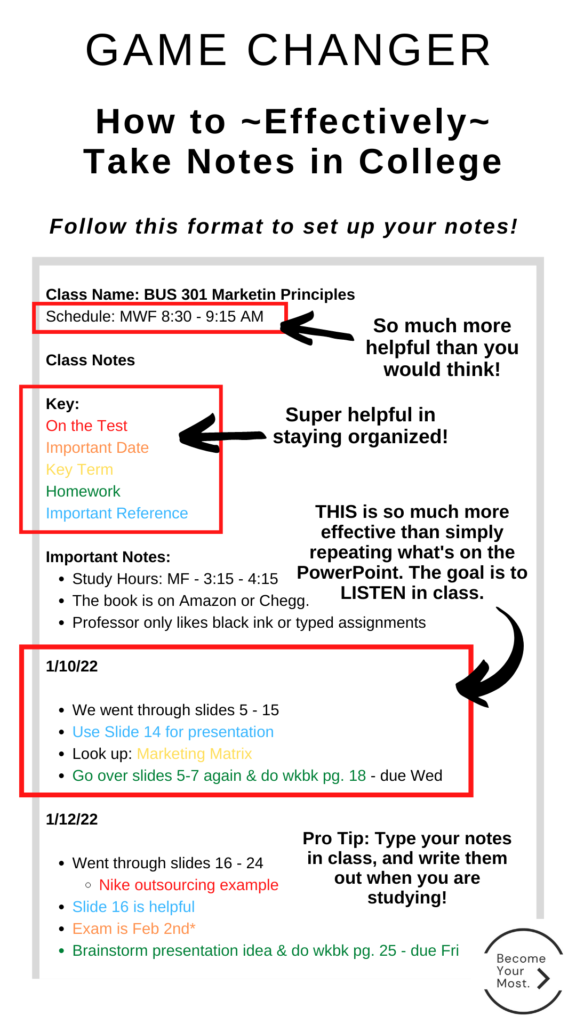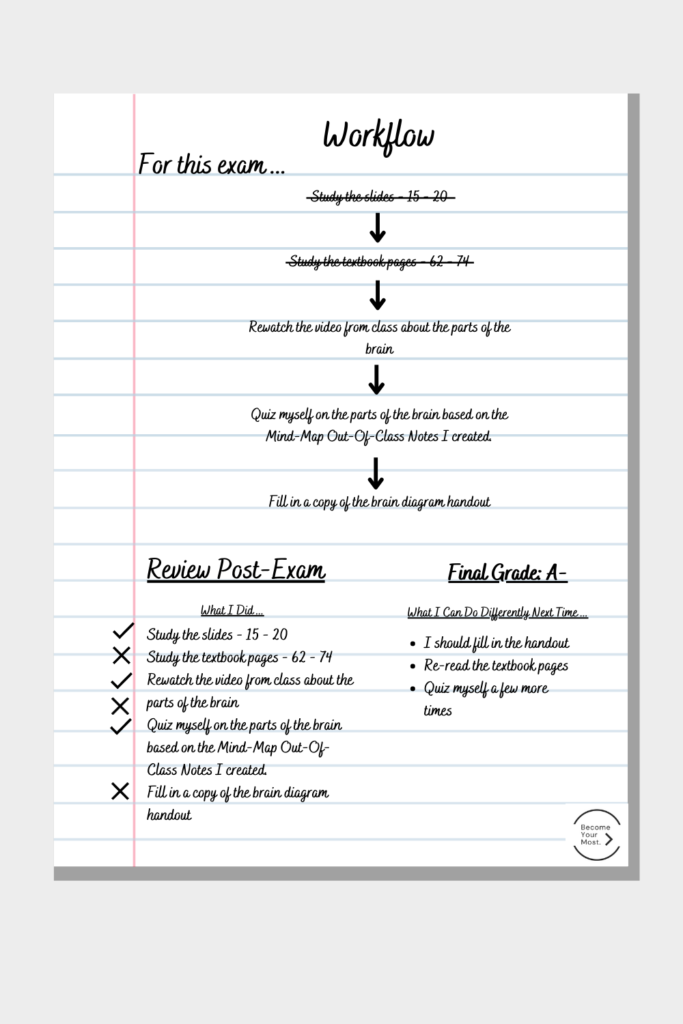Take Better Notes – The Best Guide (Transform Your Grades Now)
Estimated reading time: 6 minutes
This is the best guide to creating useful notes studying them in and out of the classroom, and debunking the best note-taking method. Ready?
This post may contain affiliate links, which means I’ll receive a commission if you purchase through my link, at no extra cost to you. Please read full disclosure here.
As an Amazon Affiliate I earn from qualifying purchases.
Step One: Understanding the Misconception Around Note-Taking Methods
Everyone has a preference whether they have been using their specific method for years, or if they have just started experimenting with better ways to take them
- Some prefer highly detailed
- Some prefer them brief on important portions
- Some prefer not to write anything down at all
There are TONS of methods:
Here are a few popular types:
Cornell
Mind Mapping / Flow
Outline
Boxing
Charting
Sentence
Slides
Brain Dumping
Bullet
There are essentially infinite ways to write them down.
Here’s what they might look like.

*** Use this visual for inspiration for creating your Out-Of-Class Notes …
Which I will discuss in Step 3
IMPORTANT: READY FOR THE SECRET?
Firstly, there is no “best” method of note-taking… because everyone is different.
There is no “one-size-fits-all”. The method that works best for you, but just like learning styles, there is no one method that will work best for you.
Sure, there are many popular ones, that many people have found success with such as the Cornell method or outlining.
It doesn’t matter which method you choose. You might even choose different styles depending on the class, topic, section, etc.
You might prefer:
- Slides Method – for History Class
- Cornell Method – for English Class
- Bullet Method – for Math Class… Etc.
It is simply a tool for organizing and creating them OUT-OF-CLASS
THERE IS NO, “BEST” LEARNING STYLE
Just as there is a huge misconception around learning styles, that people don’t just have one learning style and it is hard to predict or determine which learning style is best for a student.
Here is a great explanation and resource if you’re interested in learning more.
Most people learn better through a combination of learning styles and they vary …
- depending on their field of study
- the specific topic they are learning about
- the subject or class
- the preferences of the professor
- their profession
- their changing interests
- and much more
I recommend this TedX by Anita Acai discussing the “Misconceptions of Learning Styles”.
Step Two: Understanding How To Actually Take In-Class Notes
Don’t skip this step!!!
YOU HAVEN’T BEEN LEARNING
This took me until my senior year of college to understand. You’ve probably heard it before, but chances are it hasn’t resonated…
There is a huge pitfall many experience with notetaking: they don’t listen in class.
We’ve all been guilty of these …
- Focused on writing every, single thing down —> we aren’t actually learning.
- Slow writers —> there are missing gaps.
- Sloppy handwriting —> can’t read them later on.
- They are only focused on highlighting, organizing, etc. —> wasting our time.
- Furthermore, we don’t write anything down —> and are completely helpless later.
I have a solution for you that will solve all issues . Ready?

HERE IS HOW TO FORMAT YOUR IN-CLASS NOTES.

This method is effective because:
- This method is simple.
- You will still have notes on important pieces.
- You aren’t just copying down what is on the slide deck.
- You will actually be learning!
HELPFUL VIDEOS I CREATED – EXPLAINING FURTHER
Here is a video I created to explain how to format them!
Here is a video showing a real example of notes from a class I took
Step Three: Creating Out-Of-Class Notes
PREPARATION
Now you need to organize your notes.
You might be wondering…
“But if I didn’t write much during class, what am I organizing?”
What you are doing is gathering everything relevant to the class and creating Out-Of-Class notes.
First, you need to gather all your materials.
Examples:
- All your relevant class notes
- Any handouts or resources given to you
- Your textbook pages – Bookmarked to relevant pages
- Helpful online videos
- The slideshow
- Diagrams
- Helpful online resources
- Quizlets or flashcards
ORGANIZE YOUR NOTES
You are now creating an IN-DEPTH set of notes that are a combination of everything.
This should be based on your preferred learning style for this exam, class, topic, etc.
For example: You have an anatomy exam on Ch. 10 “The Human Brain”.
- The exam will cover:
- What the brain is
- Parts of the brain
- The functions of the parts of the brain
- You would take your in-class notes and note that they mention you should study pages 62 – 74 and slides 15 – 20.
- Therefore, you decide to create a Mind Map for your note-taking method based on those pages and those specific slides.
- Your In-Class notes also emphasize that the hormones of the brain will be on the exam. You will include those in your notes.
- You will also include on these notes relevant pieces of information, resources, etc. that were not in those textbook pages or slides, such as:
- Videos
- Handouts
- Diagrams
- Screenshots or Pictures of the WhiteBoard
These notes should be detailed, organized, clean, and easy to understand.
Step Four: Study
The biggest issue faced with studying is frankly … getting started.
Therefore, I recommend creating a workflow for how you should study for each exam or complete each project.
For Example:

This will give you a clear starting and ending point which is:
Significantly less stressful because you have a plan.
Organized so you can understand how you prepared for the exam.
Replicable for the next exam if this was effective.
Summary
There are four main steps to this process for taking better notes:
- Understanding how you learn
- Taking Effective, Short-Hand, In-Class Notes
- Creating Detailed, Organized, and Comprehensive Out-Of-Class Notes
- Study – By creating a workflow based on your notes






